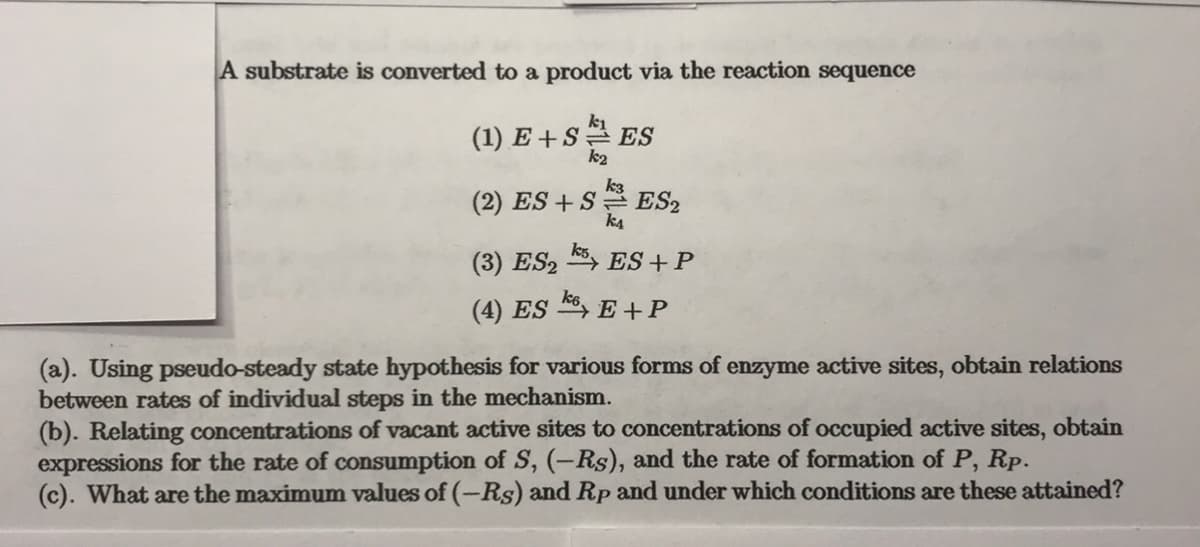A substrate is converted to a product via the reaction sequence (1) E + S ES k2 (2) ES +S ES2 k4 (3) ES2 , ES +P (4) ES , E +P (a). Using pseudo-steady state hypothesis for various forms of enzyme active sites, obtain relations between rates of individual steps in the mechanism. (b). Relating concentrations of vacant active sites to concentrations of occupied active sites, obtain expressions for the rate of consumption of S, (-Rs), and the rate of formation of P, Rp. (c). What are the maximum values of (-Rs) and Rp and under which conditions are these attained?
A substrate is converted to a product via the reaction sequence (1) E + S ES k2 (2) ES +S ES2 k4 (3) ES2 , ES +P (4) ES , E +P (a). Using pseudo-steady state hypothesis for various forms of enzyme active sites, obtain relations between rates of individual steps in the mechanism. (b). Relating concentrations of vacant active sites to concentrations of occupied active sites, obtain expressions for the rate of consumption of S, (-Rs), and the rate of formation of P, Rp. (c). What are the maximum values of (-Rs) and Rp and under which conditions are these attained?
Biochemistry
9th Edition
ISBN:9781319114671
Author:Lubert Stryer, Jeremy M. Berg, John L. Tymoczko, Gregory J. Gatto Jr.
Publisher:Lubert Stryer, Jeremy M. Berg, John L. Tymoczko, Gregory J. Gatto Jr.
Chapter1: Biochemistry: An Evolving Science
Section: Chapter Questions
Problem 1P
Related questions
Question

Transcribed Image Text:A substrate is converted to a product via the reaction sequence
(1) E +S ES
k2
(2) ES + S ES2
k4
(3) ES2
ES +P
(4) ES , E +P
(a). Using pseudo-steady state hypothesis for various forms of enzyme active sites, obtain relations
between rates of individual steps in the mechanism.
(b). Relating concentrations of vacant active sites to concentrations of occupied active sites, obtain
expressions for the rate of consumption of S, (-Rs), and the rate of formation of P, Rp.
(c). What are the maximum values of (-Rs) and Rp and under which conditions are these attained?
Expert Solution
This question has been solved!
Explore an expertly crafted, step-by-step solution for a thorough understanding of key concepts.
This is a popular solution!
Trending now
This is a popular solution!
Step by step
Solved in 2 steps

Knowledge Booster
Learn more about
Need a deep-dive on the concept behind this application? Look no further. Learn more about this topic, biochemistry and related others by exploring similar questions and additional content below.Recommended textbooks for you

Biochemistry
Biochemistry
ISBN:
9781319114671
Author:
Lubert Stryer, Jeremy M. Berg, John L. Tymoczko, Gregory J. Gatto Jr.
Publisher:
W. H. Freeman

Lehninger Principles of Biochemistry
Biochemistry
ISBN:
9781464126116
Author:
David L. Nelson, Michael M. Cox
Publisher:
W. H. Freeman

Fundamentals of Biochemistry: Life at the Molecul…
Biochemistry
ISBN:
9781118918401
Author:
Donald Voet, Judith G. Voet, Charlotte W. Pratt
Publisher:
WILEY

Biochemistry
Biochemistry
ISBN:
9781319114671
Author:
Lubert Stryer, Jeremy M. Berg, John L. Tymoczko, Gregory J. Gatto Jr.
Publisher:
W. H. Freeman

Lehninger Principles of Biochemistry
Biochemistry
ISBN:
9781464126116
Author:
David L. Nelson, Michael M. Cox
Publisher:
W. H. Freeman

Fundamentals of Biochemistry: Life at the Molecul…
Biochemistry
ISBN:
9781118918401
Author:
Donald Voet, Judith G. Voet, Charlotte W. Pratt
Publisher:
WILEY

Biochemistry
Biochemistry
ISBN:
9781305961135
Author:
Mary K. Campbell, Shawn O. Farrell, Owen M. McDougal
Publisher:
Cengage Learning

Biochemistry
Biochemistry
ISBN:
9781305577206
Author:
Reginald H. Garrett, Charles M. Grisham
Publisher:
Cengage Learning

Fundamentals of General, Organic, and Biological …
Biochemistry
ISBN:
9780134015187
Author:
John E. McMurry, David S. Ballantine, Carl A. Hoeger, Virginia E. Peterson
Publisher:
PEARSON